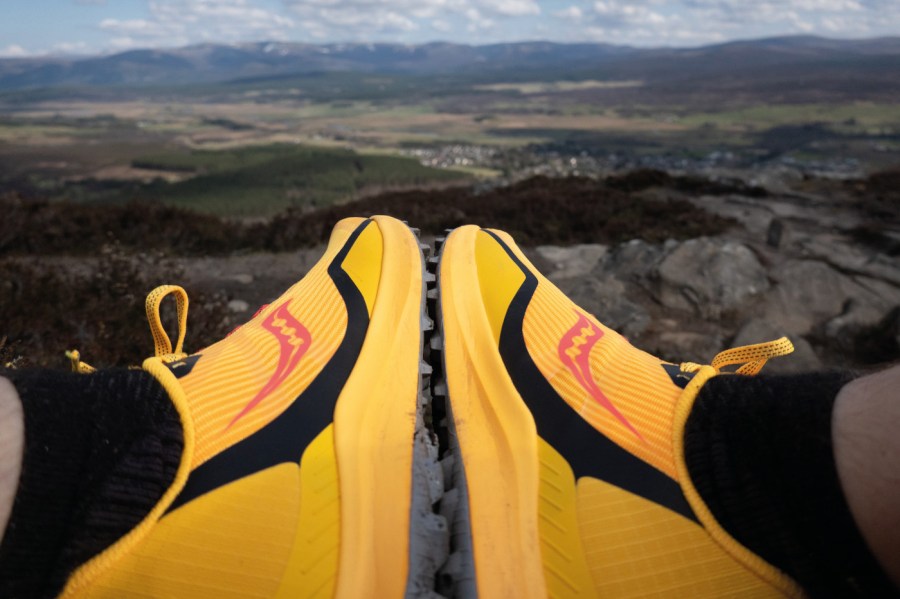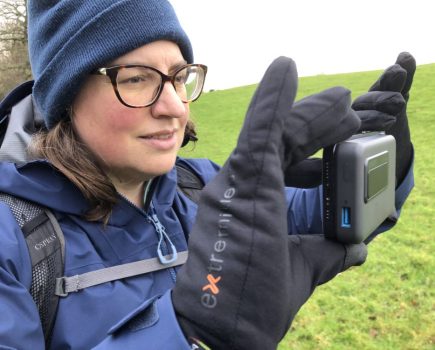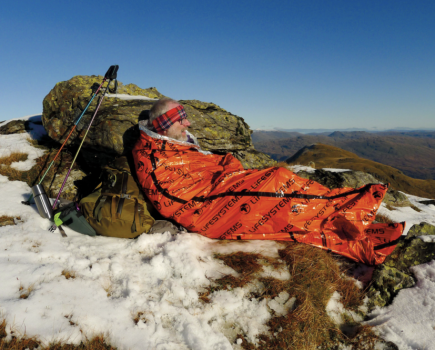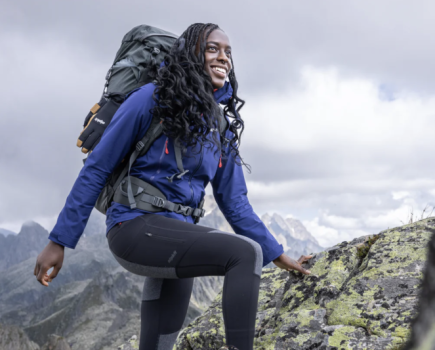We’re comparing the top trail shoes, sometimes known as “trail runners,” in this roundup. These are lightweight “trainers” with an outdoor purpose, not the fabric, three-season hiking boots or low-cut boots we may choose for hillwalking if we want to keep our feet dry. These are the preferred option for mountain and fell runners, and they are also becoming more and more popular with hikers, backpackers, and hillwalkers.
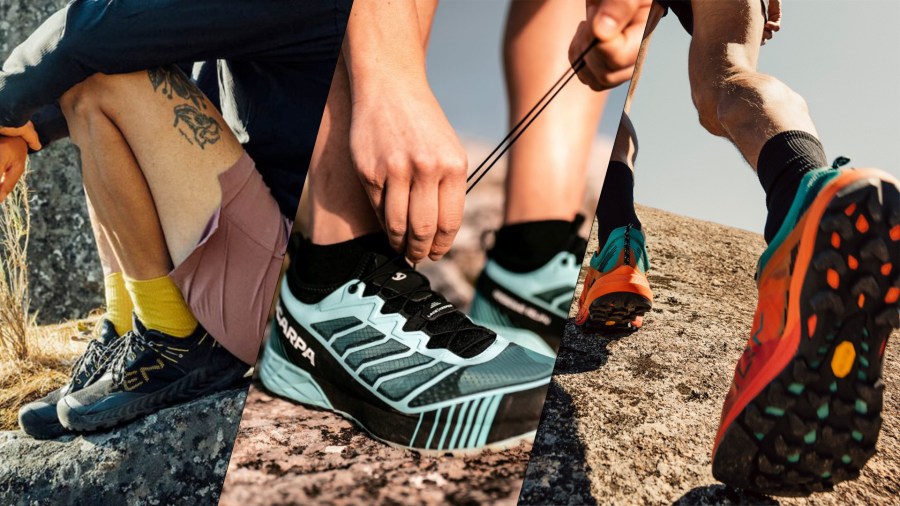
This article will showcase the top ten pairs of trail shoes for hiking, hillwalking, and backpacking. These are all lightweight alternatives, and while some are expressly built for hiking, several are trail running shoes that also perform well for hiking. Our staff has tested and examined each product.
Altra Lone Peak 7
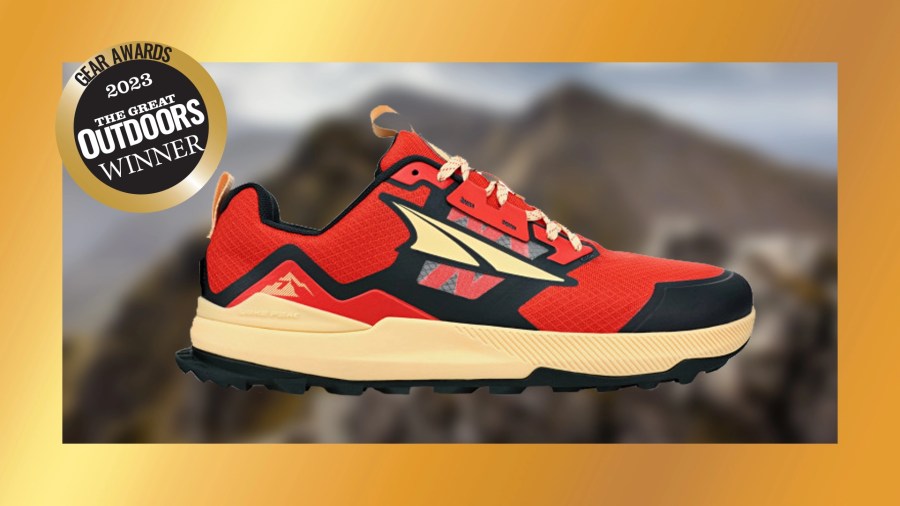
TGO Gear Awards Winner 2023
“I’ve used several versions of the Altra on long walks and they’ve been superb,” said head judge Chris Townsend in The Great Outdoors Awards.- Wide toe box accommodates foot splaying
- Aggressive outsole
- Wide toe box might not suit those with narrow feet
| Quick specs | |
|---|---|
| Price | $150 | £135 |
| Weight | 1.38 lb. | 628g |
| Heel-to-toe drop | 0mm |
| Lug depth | 4mm |
| Materials and features | 25mm stack height, Quick-Dry Air Mesh upper, Maxtrac outsole, Altra EGO midsole, footshaped toe box |
| Sizes | 6-13 |
| Women’s version | Yes |
This picked up the top award in the trail shoe category of The Great Outdoors Awards 2023 with the judges all impressed by all of its hiker-friendly features.
The first ever iteration of the Lone Peak was released in 2011 and it became an instant hit due to its unique features, including a zero-drop platform, foot-shaped toe box and aggressive outsole. Whilst primarily made for trail running, many multi-day hikers began adopting these trail shoes mainly due to the fact that they cater for the kind of foot swelling and splaying that can occur over high mileage.
The new, seventh version of the LonePeak (£135) possesses all the usual traits of past models, but with deeper lugs (4mm) and a new seamless upper material that brings a touch more durability, longevity and comfort, but with only 30g extra in weight overall.
“I’ve used several versions of the Altra on long walks and they’ve been superb,” said head judge Chris Townsend in The Great Outdoors Awards. “It’s the best footwear for long-distance multi-week walks that I’ve worn.”
See more: Altra Lone Peak 7 Wide First Look
Arc’teryx Norvan LD3
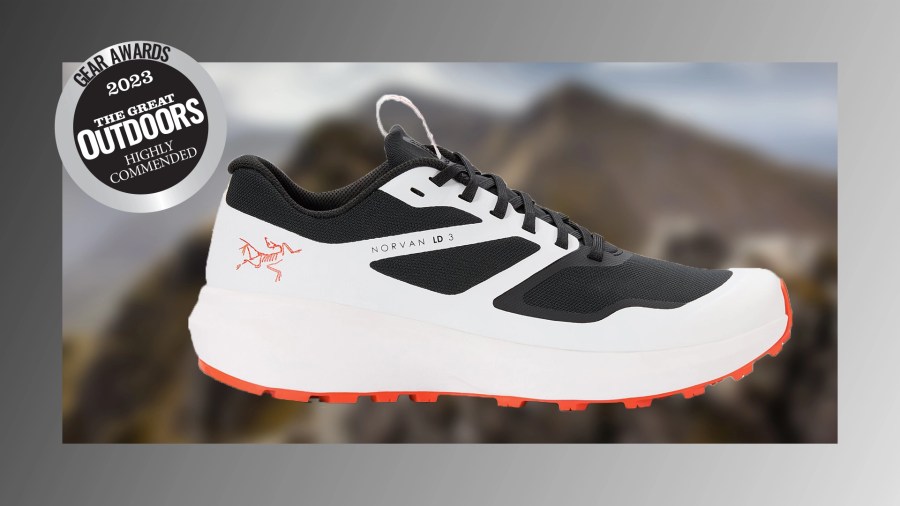
TGO Gear Awards 2023
Our judges favoured the Norvan LD3 for its balance between cushioning and lateral stiffness, the volume around the toes that allows for swelling after heavy mileage.- Grip
- Support
- High Ankle Support
| Quick specs | |
|---|---|
| Price | $163 | £150 |
| Weight | 1.34 lb. | 612g |
| Heel-to-toe drop | 6mm |
| Lug depth | 4mm |
| Materials and features | EVA/polyolefin blend midsole, single-layer mesh upper, toe cap, Ariaprene foam tongue, InFuse midsole (42 Shore C), anti-fatigue insert – 85%, internal foot wrap, Vibram MegaGrip outsole |
| Sizes | 6.5-12.5 |
| Women’s version | Yes |
The Norvan LD 3 is a quietly competent generalist. The fit is true to size, with a wide forefoot that allows for swelling in the toes, and a high, narrow heel cup that keeps the foot secure and supported. There’s less stiffness at the ankle in this version, too, which is easier on bony ankles in a deeply cupped shoe.
This was in fact chosen as Highly Commended in The Great Outdoors Awards 2023. Our judges favoured the Norvan LD3 for its balance between cushioning and lateral stiffness, the volume around the toes that allows for swelling after heavy mileage and the ‘sticky’ Vibram sole that gives traction on a variety of surfaces.
Read our full thoughts in our Arc’teryx Norvan LD3 review
Scarpa Spin ST

Fiona Russell’s best in test
The Spin STs are now a firm favourite trail footwear, especially when heading into the summer hills and mountains.- Lightweight
- Great traction
- Durable
- Lace Lock
- Lace lock might irritate
- Overlong laces
- Narrow so not ideal for wider feet
| Quick specs | |
|---|---|
| Price | £150 |
| Weight | 280g |
| Materials | stack height, 22mm to 18mm, Fixion ST sole in Vibram Megagrip, Traction Lug technology, Ortholite insole, breathable upper, high ankle collar, lace lock, lace pocket, vegan friendly |
| Heel-to-toe drop | 4mm |
| Lug depth | 7mm |
| Sizes | EU 37 to 43 |
| Men’s version | Yes |
| Brand site | www.scarpa.co.uk |
The Scarpa Spin ST trail shoes are lightweight, snug, and grippy, making them a top choice for those with narrow feet. The higher ankle collar provides low-level support for rough trails, while the medium cushioning provides comfort for off-road routes. The shoe’s ideal depth for trails is not too thick nor too thin, and the traction on wet, mud, scree, and snow is good due to deeper lugs. However, they are not suitable for long tarmac or hard-packed forest trails due to their unforgiving feel.
The uppers are durable with abrasive-resistant mesh at the mid foot, but not as breathable as other shoes. The lace-lock system is not as breathable as other shoes, but once locked, the laces stay taut. The shoe’s lace-lock system is a bit tricky, but once in place, they stay put. The Scarpa Spin ST’s are a firm favorite for trail footwear, especially for summer hills and mountains.
Read Fiona’s full Scarpa Spin ST Review
Inov-8 Roclite G315 GTX
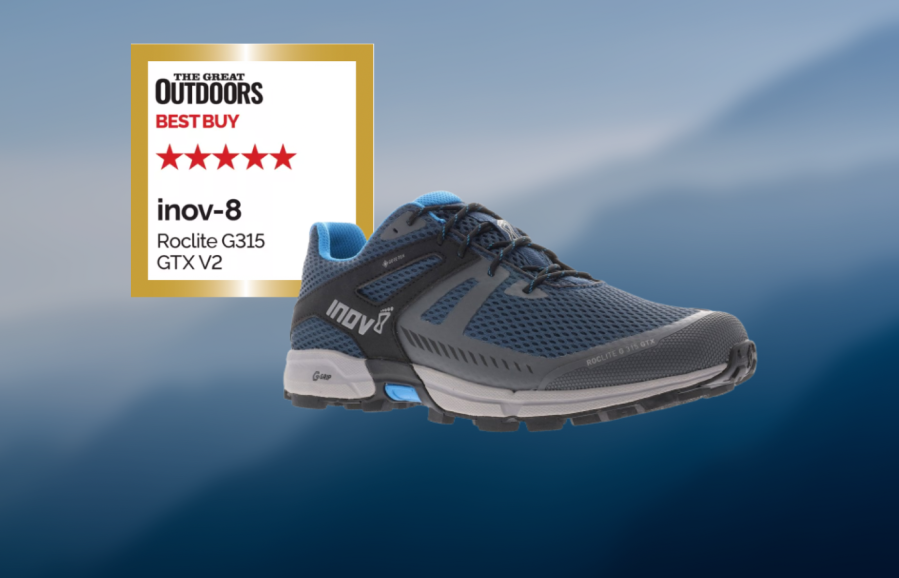
Fiona Russell’s verdict
they are ideal for outings where there is a mix of walking and running on softer and rougher terrain. The price is the highest amongst those I have tested but they are the best all-round performers.- Fit
- Waterproofing
- Grip
- Stability
- Price
- Limited upper sizes for women
| Quick specs | |
|---|---|
| Price | $190 | £155 |
| Weight | 1.47 lb. | 668g |
| Heel-to-toe drop | 8mm |
| Lug depth | 6mm |
| Materials and features | graphene G-GRIP outsole, textile upper, mid-width, Powerflow Max foam midsole, 6mm EVA footbed, Gore-Tex membrane, mid-heel lock panel, META-PLATE, front-end bumper |
| Sizes | 3-8.5 |
| Men’s version | Yes |
The inov-8 G315 is one of the best all-round performers I’ve ever tested. The outsole, with its deeper lugs, gives great traction, whilst a slimmer sole offers good ground-feel and ankle stability. There is less cushioning than other shoes on test and this could leave your feet weary if you have miles of hard-packed trails to cover. They are ideal for outings where there is a mix of walking and running on softer and rougher terrain.
Read Fiona Russell’s full Inov-8 Roclite G315 GTX V2 Review – Tested in 2023
Inov-8 Trailfly Ultra G 280
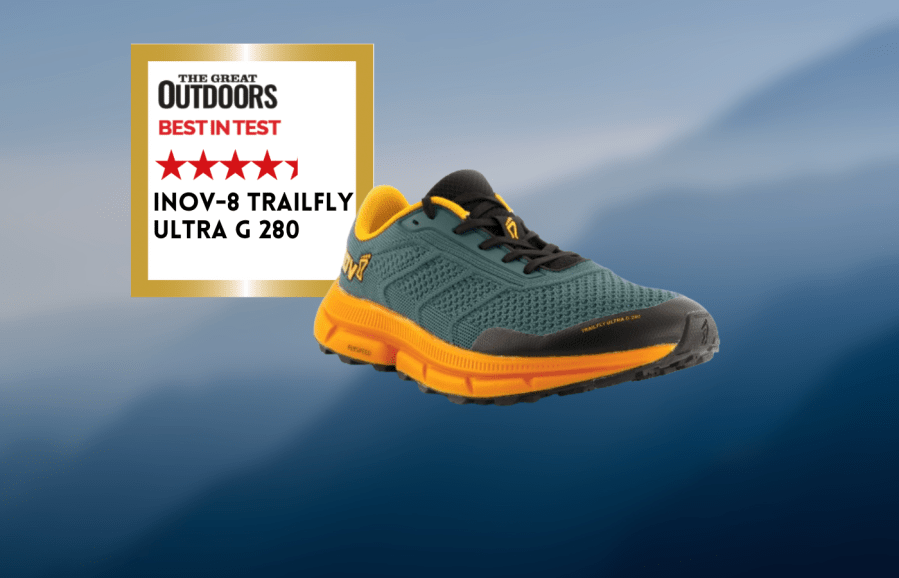
Peter MacFarlane’s Best in Test
The Trailfly Ultra is a super light trail running shoe and an excellent fit for me straight out of the box which conspired to greatly extend my first test run- Low Weight
- Comfy
- Nimble feeling
- Grippy in all conditions
- a slightly tougher toe bumper would make these perfect
| Quick specs | |
|---|---|
| Price: £145 Weight:602g pair, UK9 Materials & features: stack height: 22mm, G Grip outsole, Flyspeed midsole, wide toe box, mesh knit upper Heel-to-toe drop: 8mm Lug depth: 4mm Sizes: UK 6 to 14 inc half sizes from 6.5 to 11.5 Women version: Yes URL: www.inov-8.com |
The Trailfly Ultra G 280 is a lightweight trail running shoe that provides excellent grip and dexterity on various local trails. The shoe’s natural feel and underfoot cushioning make it suitable for both walking and running. The toe bumper is a soft spot, but a stiffer one would be perfect. The shoe’s well-shaped heel cup is supportive and has no heel lift. The forefoot is broad, allowing for more predictable foot placements. The aggressive, grippy outsole is the most reliable all-weather sole in the men’s selection.
The midsole is thickly cushioned and flexes, with a softer flex at the forefoot and a deep grove in front of the heel. The upper is a breathable mesh with ridges for strength and abrasion protection. The lacing is simple and runs well. The top eyelet sits slightly higher than other shoes, making it possible to create pressure points.
Read Peter’s full Inov-8 Trailfly Ultra G 280 Review
Altra Timp 4
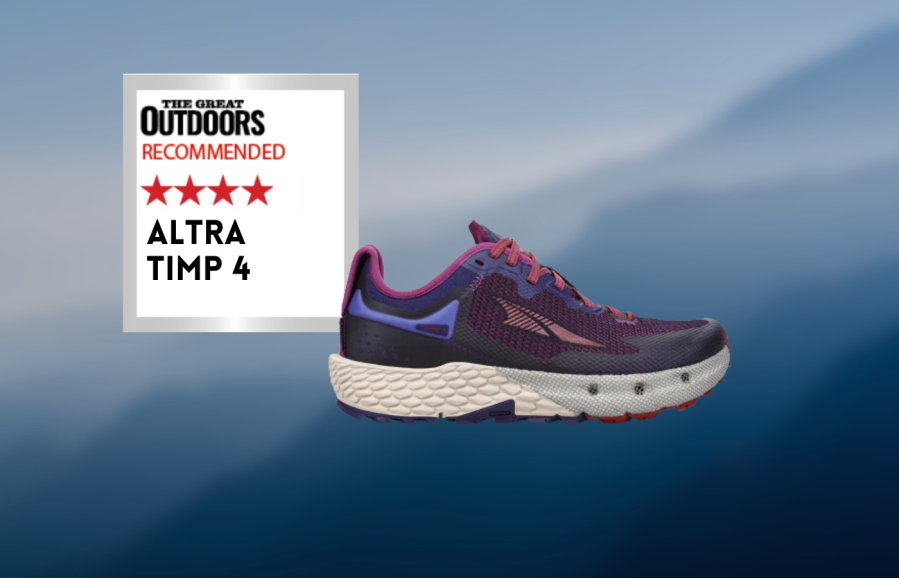
TGO Magazine verdict
Overall, the shoes are at the barefoot end of the trail walking and running spectrum and will suit people who prefer a natural feel rather than those more used to being supported by their footwear.- Comfy
- Grippy
- Cushioning
- Wide-toe-box
- Lack support
- Slippery laces
- wide toe box doesn’t suit narrow foot
| Quick specs | |
|---|---|
| Price | £135 |
| Weight | 308g |
| Materials | Stack height: 29mm, MaxRac outsole, Altra EGO™ MAX midsole, quick-dry air mesh upper, foot-shape toe box |
| Heel-to-toe drop | 0mm |
| Lug depth | 3mm |
| Men’s version | Yes |
| Brand | www.altrarunning.eu/uk/ |
The Altra Timp 4 trail shoe offers slipper-like comfort with a wide toe box, soft cushioning in the sole, and a padded ankle cuff. The shoe’s flex and pull-on loop make walking and running feel natural. However, the softness underfoot and relaxed upper provide little support, potentially causing niggles and injuries. The shoe’s wide shape gives confidence on uneven ground and is suitable for long-distance outings. The MaxTrac outsole provides good grip on most terrain, but not on steep, muddy, or grassy slopes. The uppers are made with durable mesh, an overlap rand, a toe cap, and heel protection. The laces untie easily, and trail debris collects under the lace box. The shoes are at the barefoot end of the trail walking and running spectrum, suitable for those who prefer a natural feel.
Read Fiona’s full Altra Timp 4 Review
Altra Olympus 5
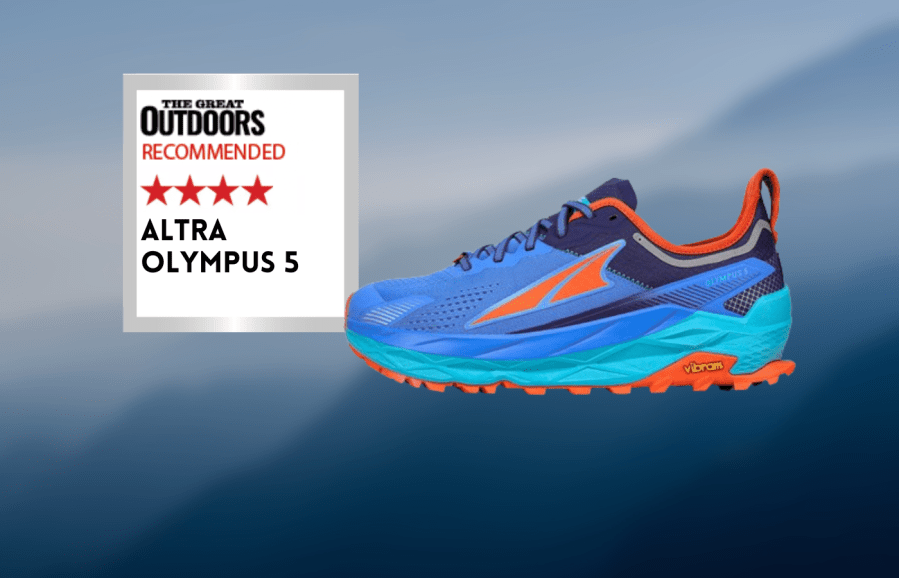
Peter Macfarlane Recommends
The Olympus grabs the eye with its quirky its design and shape and the chunky look feels at odds with the light weight of the shoes, both in the hand and once on your feet.- Long term comfort
- Fit
- Roomy toe box
- Laces are too short
- Specific fit
| Quick specs | |
|---|---|
| Price: £155 Weight: 664g pair, UK9 Materials & features: stack height: 33mm, Vibram Megagrip outsole, EVA midsole, engineered mesh upper, Original FootShape Fit Heel-to-toe drop: 0mm Lug depth: 4mm Sizes: UK 6 to 14 (half sizes 6. To 11.5) Womens version: Yes URL: https://www.altrarunning.eu/uk/ |
The Olympus 5 trail shoe is a quirky design with a chunky look that contrasts with its lightweight weight. The shoe’s sculpted shape allows extra room for toes and a natural feel while walking or running. The thick midsole cushions but doesn’t separate the wearer from the terrain, allowing them to feel rocks and roots. The large contact area of the heels adds grip and security while feeding back movement on uneven terrain. The outsole is excellent and grippy across most terrains, with deep grooves in the tread pattern adding flex and mud-shedding properties. The sole has flex but is thick enough for balance and comfort on long days on rough terrain. The upper dries quickly when wet, and the mesh fabric has plastic reinforcement at high wear points. The heel has a large pull tab and a padded inner collar. The laces run smooth but are too short for proper knotting. The shoes have gaiter attachment points and reflective detailing.
Read Peter’s full Altra Olympus 5 Man Review
Dynafit Traverse GTX
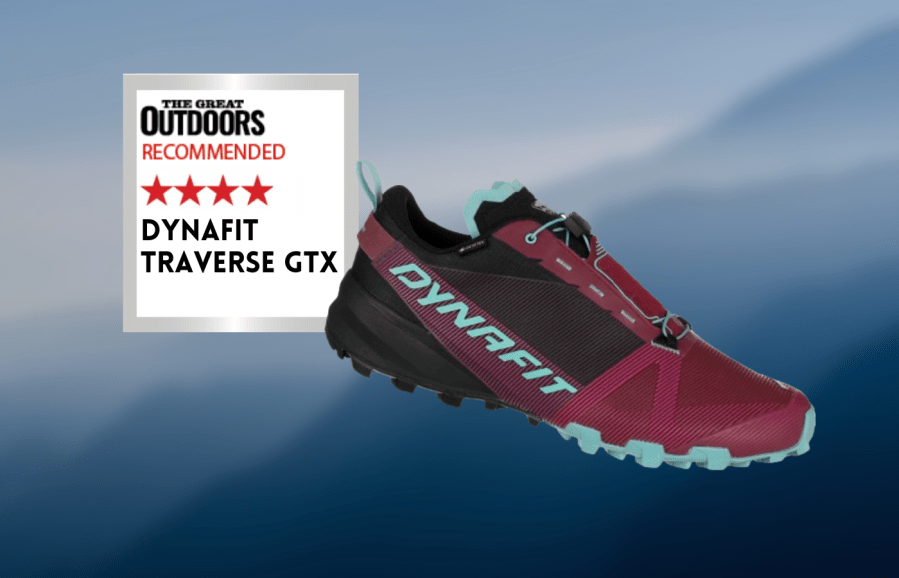
Fiona Russell Recommends
While the shoes have a Gore-Tex membrane, the wet can get in at the ankle, and I did not find the shoes very breathable in warm conditions.- Supportive
- Lacing
- Waterproof
- Size small
- Heavy
- Price
| Quick specs | |
|---|---|
| Price: £175 Weight: 346g Materials & features: Gore-Tex membrane, invisible lacing, Pomona outsole, heel preloader Heel-to-toe drop: 8mm Lug depth: 5mm Sizes: Uk 3 to 9 Women/Mens version: Yes URL: https://www.dynafit.com/en-gb |
The Dynafit Traverse trail shoes, akin to Salomon Speedcross, have a wider, more robust upper design and a familiar shape, lacing, and sole design. They offer generous underfoot cushioning, but have less ground feel and stiff soles. The shoes provide excellent support from the uppers and lacing, with the ankle cuff and tongue providing comfort. A heel preloader provides support in the heel area, giving confidence on rough terrain and wet conditions. The soles offer good grip on most terrain, but slip on steep slopes. The uppers are designed to withstand high levels of abrasion, and there is an excellent protective rand around the shoe. However, the shoes are small and heavy, making them suitable for a full size. The Gore-Tex membrane may not be very breathable in warm conditions.
Read Fiona’s full Dynafit Traverse GTX Review
La Sportiva Mutant
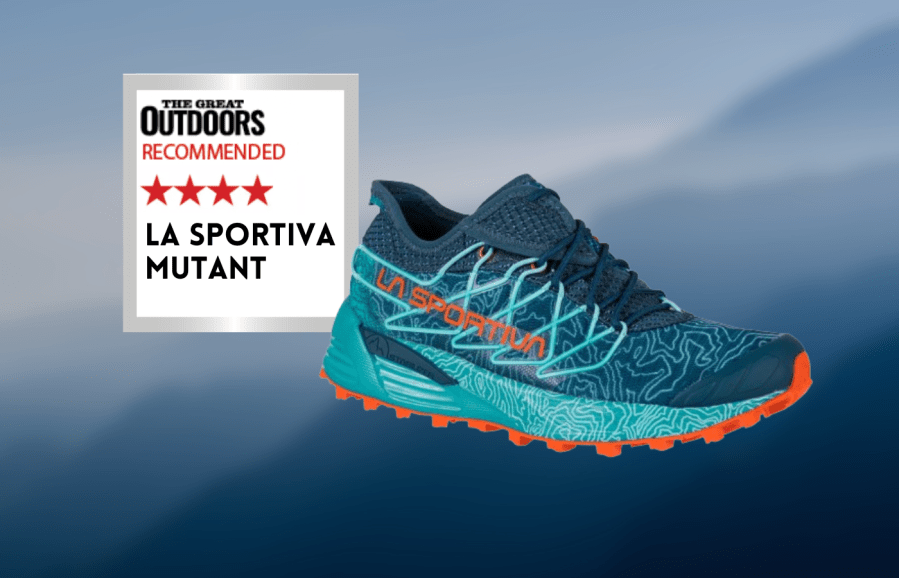
Fiona Russell Recommends
This updated model uses recycled materials and the graphics are inspired by mapping of the Val di Fiemme, the home of La Sportiva. If looks matter, these are the most attractive shoes on test.- Lightweight
- Medium width
- Side Lacing
- Size small
- Roomy heel cup
| Quick specs | |
|---|---|
| Price: £155 Weight: 324g Materials & features: FriXion XF ultra grippy outsole, injected MEMlex EVA midsole, breathable upper, integrated gaiter, Ortholite 4mm insole. Heel-to-toe drop: 10mm Lug depth: 6.5mm Sizes: EU 36.5 to 41.5 Women/Mens version: Yes URL: https://www.lasportiva.com/gb |
The Mutant trail shoe is a lightweight, moderately supportive shoe that fits like a glove at the forefoot with a wraparound tongue gaiter. It is lightweight and moderately supportive, making it easy to move from walking to running. The shoe has a medium cushioning and works well on various terrains. The V-Groove sole with FriXion XF rubber and an Impact Brake System provide good traction on most surfaces, but slips on wet rocks and tree roots. The uppers are durable but not as durable as other shoes on test. The lacing system ensures a supportive fit once tied and is set slightly off-center and inside the shoe. The updated model uses recycled materials and features graphics inspired by La Sportiva’s Val di Fiemme mapping. The shoes are attractive and suitable for those looking for a durable, supportive shoe.
Read Fiona’s full La Sportiva Mutant Review
Merrell MTL MQM
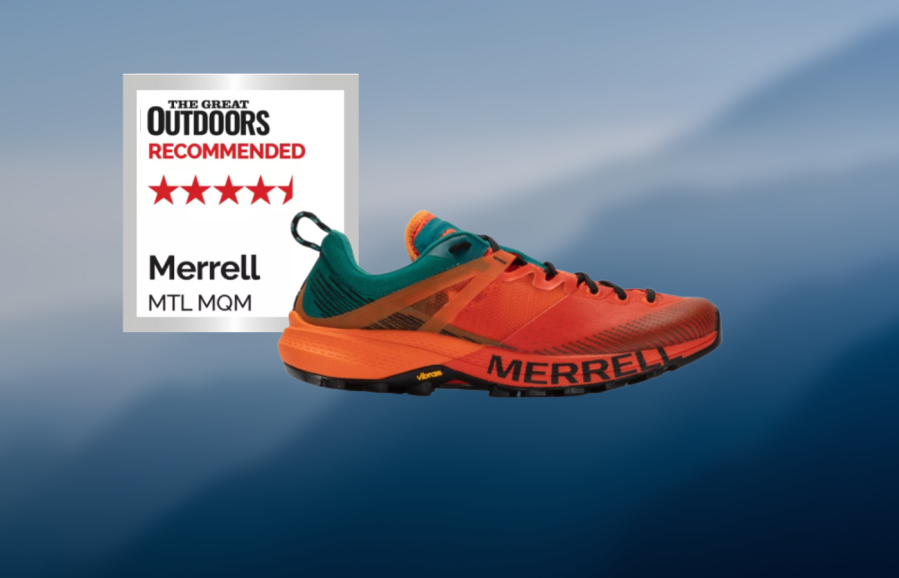
TGO Magazine verdict
These shoes are quite slipper-like; and whilst that means they are easy to wear, they might not feel sturdy enough for some people.- Lightweight
- Comfortable
- Supportive
- Durable Upper
- Cushioning
- Limited upper sizes for women
| Quick specs | |
|---|---|
| Price | $150 | £135 |
| Weight | 1.38 lb. | 628g |
| Heel-to-toe drop | 6mm |
| Lug depth | 5mm |
| Materials and features | Vibram MegaGrip and Vibram Idrogrip combined outsole, mesh and TPU upper, 100% recycled laces and webbing, internal bootie, TPU waterproof shell, microfibre lining, removable PU footbed, 100% recycled mesh footbed cover, rock plate, 50% recycled removable EVA foam footbed, FloatPro Foam midsole, pull-on rear loop |
| Sizes | 2.5-8.5 |
| Men’s version | Yes |
The internal bootie supports the mid part of the foot and under the arch, whilst the lacing system is full and adaptable. There is enough bounce and comfort on hard trails but not so much that it drains energy. They do not have a waterproof membrane, but they managed to keep out a lot of wet until damp slowly seeped in.
Read Fiona Russell’s full Merrell MTL MQM Review – Tested in 2023
Saucony Peregrine 12

David Lintern’s verdict
All in all, it’s an airy, light, super-breathable shoe for the summer, with excellent traction and a wider fit, best for lighter loads, paths and trails- Grip
- Comfort
- Lateral and heel support
| Quick specs | |
|---|---|
| Price | $84.95 | £140 |
| Weight | 1.33 lb. | 604g |
| Heel-to-toe drop | 4mm |
| Lug depth | 5mm |
| Materials and features | Rockplate, PWRRUN midsole, PWRTRACK outsole, recycled mesh upper |
| Sizes | 6-13 |
| Women’s version | Yes |
The Peregrine’s grip is probably best in test. The lugs are 5mm and don’t bat an eyelid on any ground, wet or dry. The forefoot is very wide, and the heel is quite wide, which translates into a very comfortable shoe with loads of room in the toebox. There’s very little lateral support, so the shoe bends side to side when contouring.
Read David Lintern’s full Saucony Peregrine 12 review – Tested in 2023
Columbia Men’s Montrail Trinity FKT

Peter Macfarlane Recommends
In the wet it hasn’t been so good, especially on hard surfaces which makes the Trinity a good dry or changeable weather choice.- Asymetrical lacing
- comfort
- Grip in dry conditions
- Grip not great in wet
- Hard surfaces
| Quick specs | |
|---|---|
| Price: £125 Weight: 676g pair, UK9 Materials & features: stack height: 30mm, seamless mesh upper, asymmetric lacing, Techlite+ foam midsole, OrthoLite Eco insole, Adapt Trax outsole, Flexible ESS rock plate Heel-to-toe drop: 8mm Lug depth: 5mm Sizes: UK 6 to 12 inc half sizes from 6.5 to 10.5 woman’s version: Yes URL: www.columbiasportswear.co.uk |
The Montrail Trinity FKT is a running shoe with a strong heritage in trail running and adventure racing. The upper is a breathable mesh overlayed by a protective plastic matrix, providing breathability and resistance to abrasion. The tongue and ankle are the same mesh fabric, but lightly padded internally. The lacing is asymmetric, following the contour of the foot towards the outer toes, enhancing fit and security. The heel is well-shaped with strong reinforcement, and the thick sole absorbs feedback from rough ground.
The shoe has good flex along the entire sole, including an integral rock plate for additional flex at the forefoot. The outsole has decent overall grip, with a spur at the heel for extra grip in descending. The Trinity is a lively shoe for walking and running, with a good feel, comfort, and durability.
Read Peter’s full Columbia Men’s Montrail Trinity FKT Review
Salomon OUTpulse
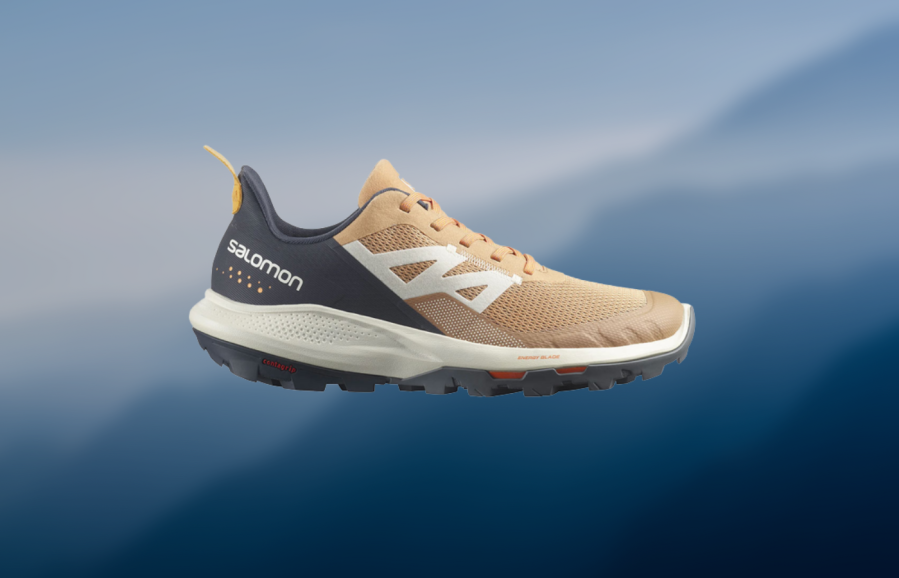
Fiona Russell’s verdict
The Salomon OUTpulse is comfortable to wear but lacks a little wow factor for me. However, the price is good for a solid, no-nonsense shoe- Comfortable
- Supportive
- Cushioning
- Size Range
- Flexibility
| Quick specs | |
|---|---|
| Price | $130 | £115 |
| Weight | 1.56 lb. | 712g |
| Heel-to-toe drop | 10mm |
| Lug depth | 4mm |
| Materials and features | All Terrain Contagrip rubber outsole, synthetic upper, textile lining, SensiFit construction, OrthoLite insole EVA mid-sole with reverse camber, Fuze Surge foam compound sole, Energy Blade TPU plate, All Terrain Contagrip rubber outsole, PFC-free, protective toecap, pull-on rear tab |
| Sizes | 3.5-10.5 |
| Men’s version | Yes |
The Salomon OUTpulse is of average weight, comfort, support and underfoot flexibility. The sole is a little too stiff and ‘clumpy’-feeling for easy ‘flowy’ running, but it’s fine for a job here and there. It’s comfortable to wear but lacks a little wow factor. However, the price is good for a solid, no-nonsense shoe.
Read our full thoughts in our Salomon OUTpulse Review
Keen NXIS EVO Waterproof
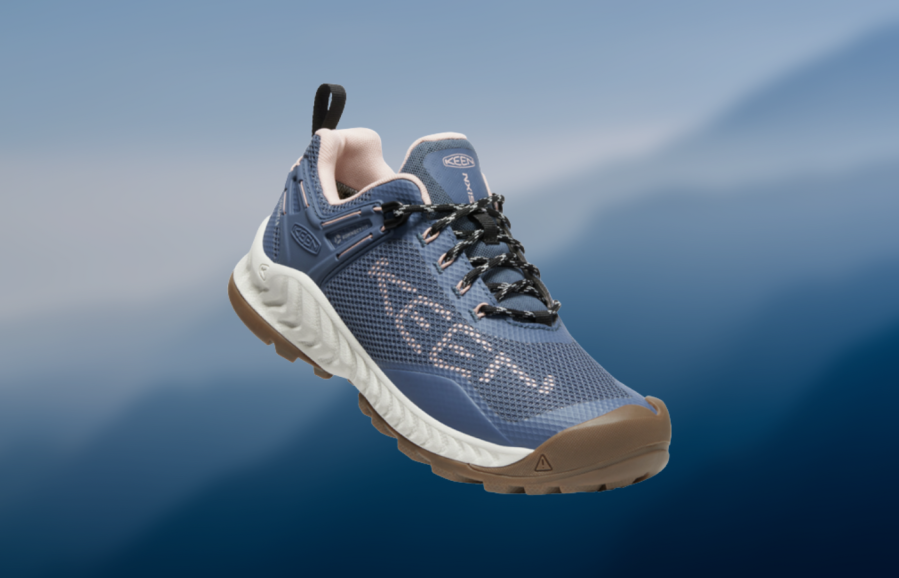
Fiona Russell’s verdict
I have found it to be a good workhorse walking shoe and its cheerful looks make me, and other people, smile on the trails and hills. The price is reasonable, too.- Durable
- Wide fit
- Cushioning
- Size range
- Weight
| Quick specs | |
|---|---|
| Price | $180 | £130 |
| Weight | 1.71 lb. | 776g |
| Heel-to-toe drop | 7mm |
| Lug depth | 4mm |
| Materials and features | Mesh upper with TPU overlays, injected EVA midsole, KEEN.ALL-TERRAIN rubber outsole, PU insole, KonnectFit heel-capture system, stability shank, speed-lace webbing system, KEEN.DRY waterproof membrane, Eco anti-odour, PFC-free DWR |
| Sizes | 2.5-9 |
| Men’s version | Yes |
The Keen NXIS is a fairly stiff shoe, with a solid outsole and an oversized toe cap. In hot weather, the thick and waterproof uppers made my feet feel a bit sweaty, so I would keep these for chillier days. The sole and uppers are stiffer than my normal running shoes, which is fine if you do more walking than running.
Read our full thoughts in our Keen NXIS EVO Waterproof review
Our Experts views on Trail Running Shoes
The Great Outdoors has long promoted the use of lighter-weight hiking footwear in the warmer months, primarily via the reviews and trip reports of Chris Townsend… and many of us have followed in his footsteps. Up until a decade or so ago, I (David) assumed that ‘proper hillwalkers’ had to wear old-fashioned leather boots all year round: that was the uniform. But I tried on lighter boots and then trail shoes, and felt far less tired at the end of the day. My ankles and toes were allowed to flex (just like they were designed to!); and without a so-called waterproof membrane, my feet could breathe and were liberated from sweating and blisters. Apparently, I was not a ‘proper hillwalker’, but that was OK!
In 2011, I hiked for two months across the Pyrenees. At that point, I wasn’t quite brave enough to take the plunge completely, and I began the walk in a pair of traditional three season, lined boots. Early on, conditions alternated between very hot and very wet, and I got a nasty case of trench foot. My feet were in such poor shape by week four I thought I would have to stop. Only the liberal application of iodine (quite an old-fashioned remedy; not sure I’d it recommend now!) dried the skin out and saved the hike. I replaced those manky boots with a pair of very lightweight, no-membrane trail runners – and had zero issues thereafter.
The more I used trail shoes for hiking, the more I understood the benefits. Less weight meant I felt nimbler and less clumsy. I paid more attention to where I put my feet and began to engage more with the terrain. My joints became stronger, my footwork more precise. I rarely get blisters now.
There are tradeoffs, of course. Trail shoes without a ‘waterproof’ membrane mean feet get wet. Conversely, they dry out more quickly when it stops raining. Carrying very heavy loads or moving in very rough terrain can warrant a larger drop in the heel or more protection in the toe than some trail shoes offer – although there are now options to cater for the ultramarathon and skyrace scenes that go a long way to mitigate those concerns, some of which we look at here. And, of course, trail shoes are not built for winter; so we shouldn’t expect them to play well with crampons and axes. But by and large, between April and October, I’m far more fleet of foot in ‘hill pumps’.
How we tested the trail running shoes
Women’s trail running shoes
Fiona is a size U.S. 10.5 / UK 8.5 and has a narrow foot. She is a keen trail and hill runner, as well as a hillwalker. To test the trail shoes, she walked and ran in each pair on the full range of terrain, from forest tracks to off-path mountain slopes, through peat hags, bog and streams and on ground covered in tussocks, heather, rocks, stones and grass. The product weights are per pair and are taken from Fiona’s digital scales.
Men’s trail running shoes
David Lintern
David is a size U.S. 11.5 / UK 10.5 and has a wide forefoot and a narrow heel. He’s an occasional trail and hill runner, and an advocate for trail shoes for walking and backpacking during the summer months. These trail shoes were tested last spring, summer and autumn on- and off-trail in the mountains throughout Scotland, from the north-west to the Borders – walking, backpacking and on the odd hill run.
Peter Macfarlane
Peter is long time user of trail running shoes in the outdoors for activities ranging from long distance paths to walking the Munros. He has also been a sporadic trail runner over the years and used these test models to retune his running feet around his local trails in the Kilpatrick Hills.
Peter has a narrow heel and wide forefoot and the weights are taken from his own digital scales.
What makes a good trail shoe for hiking?
Outsole
Soles should offer a level of grip to suit your chosen terrain, and you’ll see deeper and more densely packed lugs on shoes that aim to offer more grip on wet, muddy and steep ground.
Stiffness
Traditional trail walking shoes are usually designed with a stiffer sole because the motion of walking, compared to running, requires less flexibility. If you want to use your trail shoes for walking and running, it’s a good idea to ensure they are flexible enough to complement your natural running gait. There is a compromise to be found here, though, because a shoe that is too flexible will not necessarily be as comfortable when walking long-distance when more support is usually required.
Rock plate
Some shoes have a rock plate, which is a material embedded between the outsole and the midsole for underfoot protection. It can add stability and stiffness to the shoe and helps to protect the soles of your feet from sharp rocks and stones.
Midsole
The level of cushioning is a personal choice, but you should think about where you will be walking and running. A shallower sole usually means there is less cushioning and better ‘ground feel’, whilst deeper soles are likely to offer greater levels of cushioning. On rough terrain, a deeper sole may result in instability for some.
Heel-to-toe drop
Regardless of the depth of sole, shoes offer a range of heel-to-toe drop and that is the difference in height – usually in mm – of the stacked heel to the forefoot. Road running shoes will normally have a larger drop, often with the aim of protecting the Achilles tendon from being overly stretched, whilst trail running shoes usually have a much shallower drop.
Uppers
Trail shoes need to be durable and offer protection against abrasion caused by vegetation, rocks, stones, scree and mud. Expect to see a protective rand around the base of the upper where it meets the sole, as well as toe bumpers or caps and heel protectors. There should still be a good degree of upper flexibility so foot flex and breathability aren’t inhibited.
Waterproofing
A built-in waterproof liner, such as Gore-Tex, will offer some waterproofing if you are walking or running in the rain, on wet ground or when crossing streams and rivers. Waterproof liners can make the shoe less breathable, so you end up with sweatier feet in warm conditions. To stop the wet getting in at the ankle area, you can wear lightweight running gaiters.
Lacing
Whether traditional lacing or another system, the aim should be for an even tension along the length of the foot.
Weight
Weight should be considered against sturdiness. Generally, very lightweight shoes will not be as long-lasting or durable as a heavier shoe; although this also does depend on the materials and construction quality.
Recycled materials
More now than ever, brands are keen to inform consumers about recycled content in their products. This is good news, but it’s important to consider the potential for ‘greenwashing’ and also more than just the materials. How and where the products are made, end-of-life recycling schemes, sustainability certifications and pledges are all worth considering.
Related: Best waterproof jackets reviewed
Related: Best three-season sleeping bags reviewed

